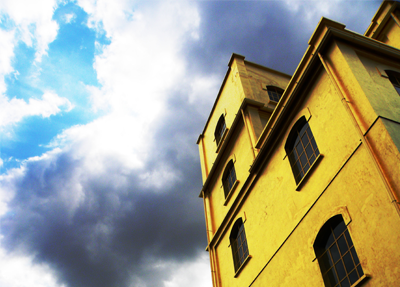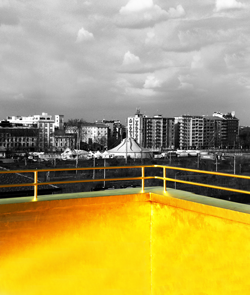You are in: Home page > Magazine > The new Prada Foundation

Paolo Strina
The new Prada Foundation
An "architectural colossal"
Abstract
The "dismission's landscape" is now an important resource for regeneration strategies, based on “constructing the built” practice. The complexity of disaster recovery is often reflected in the spectacular image of the results obtained; the new Rem Koolhaas's Prada Foundation is the perfect example. These operations cannot be taken as best-practices if they are sporadic and only bound to contexts in which strong private interests persist in ensuring “all star cast" for "architectural colossal".
The Prada Foundation in the Southern suburbs of Milan is one of the greatest Italian “show off” focused on recovering dismissed areas. Private capital, world archives and personalities of cinema and arts jet-set have contributed to create a "colossal architectural" whose cast is so composed:
buyer Prada family
architect Rem Koolhaas
Bar Light designer Wes Anderson
actors-artists, permanent and temporary Lucio Fontana, Damien Hirst, Alberto Burri, Robert Gober, Louise Bourgeois and many others.
A refined, conservative but brave project that, through the sophisticated use of materials and the introduction of new emerging plastic volumes, retrains a former distillery and transforms it into a piece of author worthy of Corso Como.
The message that comes from it is contained in the author's words: "The Golden Tower wants to be a signal, a way to understand the richness of this part of the city, a further invitation to confront. Because, I am convinced, art, architecture and culture in general can only benefit from comparison. (...) I thought that gold, the most obvious symbol of wealth, could be the most effective tool: it was enough to use it to give value to what was before, to transform what was poor in rich."
This purpose, in part even not in essence, joins the Pasolini's vision of the periphery, according to which the hand of man has created ugliness without valid and unmistakable motivation, conditioning its internal lifestyles. Koolhaas, with his gesture, takes the distance from the discriminating vision of the suburbs like b series places, just conurbations of the consolidated city, trying to get them, perhaps not too much respectfully of their urban role, through beauty. Up to this point, it would be a noble intent; Renzo Piano himself in his "politics" of "mourning" of the suburbs, is part of that assumption.
However, others operations of urban transformation are started from similar concepts; let's consider the Maxxi in Rome designed by architect Zaha Hadid and inaugurated in 2009 as a flywheel of a wider regenerative strategy, still unpublished today. The sculptural form of the architectural object, strongly refusing private capital, can be traced back to the "white elephant", a phenomenon that continues to be imperiled because of a lack of public guidance on a real regenerative process, in which architecture can't be considered a "single-form", but, must represent the hardware of the urban device. From such assumptions, often social capacitors are too addicted to private investors, strong powers, public administration health, and then fashion, the constantly changing lifestyle, the momentarily passions, from people's spare time quality to social class of the audience. All secondary factors compared to the real determinant of the success of a regenerative strategy: the prevalent social fabric formed by the inhabitant. At the opposite is the great urban revolution that is crossing the city of Bordeaux, in southwestern France. An open-air yard, a sign of a cultural renaissance from the outskirts, docks, river port, areas that have always characterized the city itself as the French gateway to the Atlantic ocean. "La Cité du Vin", in this case, is comparable to the Maxxi or Prada Foundation. The spectacular shape of the container resembling a giant decanter, as in the best pop tradition, carries the image of a popular identity and culture indissolubly linked to wine since the times when river transported the barrels in the country and abroad. The "decanter", however, opens in parallel (or slightly earlier, probably as a surplus generator and charges that can be hijacked on other actions) to an integral upgrading of the urban construction fabric that, by means of oil spills, protrudes to the ancient nucleus understood. Specifically, the decanter becomes a tourist attraction within an urban area where the people's comfort lifestyle is the very first goal. The "talking duck" exclusively consolidates an extraurban / metropolitan /territorial stream.
The examples shown are all embedded in metropolitan-globalized contexts in which the spectacularization of the disposition is emphasized by the media and the political attention on the urban centers of the widespread interest, which, however, is low in the "undergrowth" of small towns . The figure of a new architect is outlined. After the architect-artisan and the architect-led, now is the era for an "architects-director" who can imagine a complex plot to be played on the peripheral set, backed by serious political will and appropriate regulatory tools. A style less magniloquent then the Koolhaas one, and much more neo-realist, responding to necessities for contexts in which resources are lacking in the spectacularization of the regenerative process. The architectural object of the Prada Foundation represents, perhaps, from the top of its golden tower dominating the periphery, an example in which the architect-director has imagined a plot not for everyone, but for that glamorous world that breathes by living it. If the external casing establishes a dialogue with the surrounding identity, the interior makes it counterpoint. The desire to extract the selected user from the contour conditions through interior and exterior spatial imagery, starting from a Milan "liberty" atmosphere and then going to the boutique, suggests the conscious will of the architect, and perhaps the client, to deny peripheral nature in order to project the guest into an almost dreamlike dimension, in which self-prophetic prophesies a dystopian future. The periphery does not only require elitist squares but community squares where the integration between the parties takes place in accordance with their urban role. This is the mission of the architect-director: through the heterogeneity of the "cast", imagine competent regeneration strategies that do not require "architectural colossal" to become "classical" urban reference within a state of the art which does not allow stellar productions but which, on the other hand, gives more space to spontaneous actions, self-construction and self-management activities by actor-producers even through the key of the ephemeral.
References
Martino P., Verbaro C. (2016) Pasolini e le periferie del mondo. Ets, Pisa.
Prandi E., Amistadi L. (2011) European city architecure. Project, Structure, Image. FAedizioni, Parma.
Strina P. (2016) "Il potenziale delle aree dismesse. Il caso della ex Bormioli a Parma" in Urbanistica Informazione, 269-270, 92-96.
Debord G. (1967) La società dello spettacolo. Gallimard, Parigi.
Venturi R, Brown D. S. (1977) Learning from Las Vegas, MitPress, Cambridge.
Venturi R. (2002) Complessità e contraddizione nell'architettura. Dedalo, Bari.
Fuksas M. (2007) La civiltà dei Superluoghi. Damiani, Bologna.
Prandi E., Amistadi L. (2011) European city architecure. Project, Structure, Image. FAedizioni, Parma.
Strina P. (2016) "Il potenziale delle aree dismesse. Il caso della ex Bormioli a Parma" in Urbanistica Informazione, 269-270, 92-96.
Debord G. (1967) La società dello spettacolo. Gallimard, Parigi.
Venturi R, Brown D. S. (1977) Learning from Las Vegas, MitPress, Cambridge.
Venturi R. (2002) Complessità e contraddizione nell'architettura. Dedalo, Bari.
Fuksas M. (2007) La civiltà dei Superluoghi. Damiani, Bologna.
On-line references
http://www.bordeaux-metropole.fr
http://lafab-bm.fr/
Paolo Strina, architects, has a Ph.D title in architectural composition at University of Parma. He is a member of a research group UAL, Urban and Architectural Laboratory. Since 2015 he conduce the private practice inside his architectural office called PSAtelier. In 2017 he has co-founded the InHabit cultural association; a permanent laboratory about the contemporary "inhabit" phenomena.















